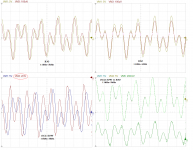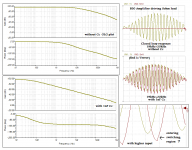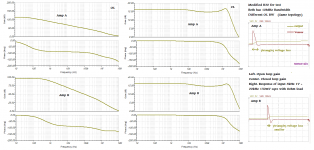[OT]
BTW, some % of positive crosstalk also does generally broaden the soundstage, mostly in depth and height, and creates "bigger" phantom sources (with any material containing close "copies" of a signal in the L/R-channels and a interchannel delay between them). Comb filters triggering HRTF-based localization cues, generally speaking...
-Klaus
[/OT]
It's by far not that easy, Jan. I have ten years of private research on those matters on my back (manipulation of phantom source properties, and manipulations for both individual tracks as well as fully mastered music).Not at all. They do that by inserting some of the L signal into the R channel, in opposite polarity, and vice versa. There's no mysterious time shifting (whatever that means) involved.
jan didden
BTW, some % of positive crosstalk also does generally broaden the soundstage, mostly in depth and height, and creates "bigger" phantom sources (with any material containing close "copies" of a signal in the L/R-channels and a interchannel delay between them). Comb filters triggering HRTF-based localization cues, generally speaking...
-Klaus
[/OT]
[snip]The opamp alone has problems to handle square waves.[snip]
Which opamp? The one I normally use for audio runs rings around audio signals, transients or not.
[snip]SY could claim he heard no difference to prove him correct.
.
It is impossible to proof a negative. Controlled testing 101.
[snip]SY, you are moderator?
Be fair.
This is sooo low that I don't know what to say.
jan didden
This is sooo low that I don't know what to say.
Ok, I apoligize. I hope you haven't misunderstood it. (It was no threat or so)
Nonetheless I will feel better if not only SY but also a further person makes the opamp test.
I understand you all and your concerns. It is not explainable from a first technical point of view.
But this is the point. We can find something out.
Last edited:
Please read my suggestion in #384 of this thread.
I am convinced, based on my own experimentation, that you will not be able to distinguish a well implemented well designed opamp from a direct feed through in ABX testing. The question to me appears to be more: how many opamps of a certain kind do you have to daisy chain before you start to hear a difference with a direct feed.
vac
I am convinced, based on my own experimentation, that you will not be able to distinguish a well implemented well designed opamp from a direct feed through in ABX testing. The question to me appears to be more: how many opamps of a certain kind do you have to daisy chain before you start to hear a difference with a direct feed.
vac
Not at all. They do that by inserting some of the L signal into the R channel, in opposite polarity, and vice versa. There's no mysterious time shifting (whatever that means) involved.
jan didden
That will do nothing to a mono signal but change the level.
Last edited:
The operation of an effects box (which does a gross amount of interchannel mixing) is unrelated to feedback in an amplifier. There are no phase "anomalies."
Thats not what I said or what I meant. I said I dont believe there are phase "anomalies" in a a good amp, and if the amp is really effecting the sound stage width there is a problem with the amp and it may be phase "anomalies".
Sorry I brought it up.
cbdb, I know you didn't say it. Everything you've said here was clear and on-point. Sorry if you felt that my criticism was directed at you.
sorry for not reading all the posts...
have you concidered parasitic oscillations as a source of effects like "narrowing of sound stage"?
to my expierience they can do a lot of harm.
one could argue that lo feedback systems might be less prone to parasitic oscillations, and thus are more easily/frequently percieved as "better sounding"
have you concidered parasitic oscillations as a source of effects like "narrowing of sound stage"?
to my expierience they can do a lot of harm.
one could argue that lo feedback systems might be less prone to parasitic oscillations, and thus are more easily/frequently percieved as "better sounding"
Please read my suggestion in #384 of this thread.
I am convinced, based on my own experimentation, that you will not be able to distinguish a well implemented well designed opamp from a direct feed through in ABX testing. The question to me appears to be more: how many opamps of a certain kind do you have to daisy chain before you start to hear a difference with a direct feed.
vac
I trust you. But:
Square-waves are different from sinus-waves.
sorry for not reading all the posts...
have you concidered parasitic oscillations as a source of effects like "narrowing of sound stage"?
to my expierience they can do a lot of harm.
one could argue that lo feedback systems might be less prone to parasitic oscillations, and thus are more easily/frequently percieved as "better sounding"
I have only changed the opamp.
By the way, just before I changed to opa2134 I only knew that there would be an improvement like lower distortion, solution etc. I didn't know that the opa2134 is not spectacular in soundstage.
Then I heard the opa2134 and the soundstage was nearly lost. I would have never bought the opa2134 if I had known that the soundstage is so disappointing. After that I was looking in the internet for similar statements. And yes, other people made the same experience. That prooved to me I am right.
But
I want to motivate other people here to test it. I want to proove and discuss it with pros.
Last edited:
Linkwitz works with it. I work with OPA134 in my design at hand. Reason: can't hear difference, can't measure difference, between direct feed, and through this particular opamp. Am sure there is more than a hand full on the market that can perform in a similar way. What I like about this particular opamp is furthermore that it is very stable in filtering applications.
There is no foundation for a statement that these opamps would ruin the soundstage in any way. Even in large filter cascades, they preserve phase perfectly coherently between two identical sets. That is all that is needed to recreate soundstage.
There is no foundation for a statement that these opamps would ruin the soundstage in any way. Even in large filter cascades, they preserve phase perfectly coherently between two identical sets. That is all that is needed to recreate soundstage.
This is some differences between two amp, only phase differences and small distortion appear.
May because OPA134 is very slow, Only 8Hz OL bandwidth while NE5534 is 1kHz, TL081 is ~30Hz and NJM4565 is unknown (but it is wideband opamp). Also OPA high OLG boost very big Verror while handle fast changes with that 8Hz OL BW (must be very big Cc inside).
Oscillating or ringing inside device could be happened in this condition.
May because OPA134 is very slow, Only 8Hz OL bandwidth while NE5534 is 1kHz, TL081 is ~30Hz and NJM4565 is unknown (but it is wideband opamp). Also OPA high OLG boost very big Verror while handle fast changes with that 8Hz OL BW (must be very big Cc inside).
Oscillating or ringing inside device could be happened in this condition.
Attachments
...
There is no foundation for a statement that these opamps would ruin the soundstage in any way. Even in large filter cascades, they preserve phase perfectly coherently between two identical sets. That is all that is needed to recreate soundstage.
You are right. I have been misunderstood.
It is the opposite way as thought.
The OPA2134 is neutral or realistic.
The NJM4565D has a unrealistic soundstage!
sorry for not reading all the posts...
have you concidered parasitic oscillations as a source of effects like "narrowing of sound stage"?
to my expierience they can do a lot of harm.
one could argue that lo feedback systems might be less prone to parasitic oscillations, and thus are more easily/frequently percieved as "better sounding"
That could be if feedback amplifiers, as a rule, more or less always oscillate, which is not true. It's generally only the occasional incompetent design or a diy design that oscillates.
Edit: not that a diy-er is incompetent but because they often have no equipment to check for oscillations and are not aware of it.
jan didden
This is some differences between two amp, only phase differences and small distortion appear.
May because OPA134 is very slow, Only 8Hz OL bandwidth while NE5534 is 1kHz, TL081 is ~30Hz and NJM4565 is unknown (but it is wideband opamp). Also OPA high OLG boost very big Verror while handle fast changes with that 8Hz OL BW (must be very big Cc inside).
Oscillating or ringing inside device could be happened in this condition.
Well, actually the error voltage depends on the loop gain at the frequency you are looking at. So if you have two opamps with 40dB loop gain at 10kHz, and one has an 8Hz OLBW and the other 1kHz OLBW, they will have exactly the same error voltage at 10kHz.
jan didden
Please read my suggestion in #384 of this thread.
I am convinced, based on my own experimentation, that you will not be able to distinguish a well implemented well designed opamp from a direct feed through in ABX testing. The question to me appears to be more: how many opamps of a certain kind do you have to daisy chain before you start to hear a difference with a direct feed.
vac
There's an article in the next Linear Audio issue which addressed exactly that.
jan didden
This is some differences between two amp, only phase differences and small distortion appear.
May because OPA134 is very slow, Only 8Hz OL bandwidth while NE5534 is 1kHz, TL081 is ~30Hz and NJM4565 is unknown (but it is wideband opamp). Also OPA high OLG boost very big Verror while handle fast changes with that 8Hz OL BW (must be very big Cc inside).
Oscillating or ringing inside device could be happened in this condition.
You have unfortunately repeated a very common misconception about the relationship of open loop bandwidth and input stage error. As explained in my book, all else remaining equal (e.g., same gain crossover frequency, closed-loop gain, etc.), the amplifiers with lower open-loop bandwidth, and consequently higher open-loop gain at low frequencies, have input error signals that APPEAR to be much more peaky, BUT they look that way not so much because the peak amplitude of the error is larger, but rather because the remainder of the error signal after the initial transition has been greatly reduced in amplitude by the larger amount of NFB at low frequencies.
Cheers,
Bob
May be this one, dunno for really, small voltage loss on rising and add for falling could change HF waveform, or not? may be too small.
Also higher DC OLG is slower for amplifiers, and same BW are not the same speed anyway. Is that not true?😕
Offcourse there may still so many other things happened there with bigger affect.
Also higher DC OLG is slower for amplifiers, and same BW are not the same speed anyway. Is that not true?😕
Offcourse there may still so many other things happened there with bigger affect.
Attachments
Thanks for correcting, This picture show it is BW that reduced by Cc, and some spike.
Exactly. With the higher Cc you reduce the gain at 1kHz where you are measuring, and therefore you see higher error. As is predicted. If you would have been measuring at a frequency where the OL gain would still be the same, you would have seen no difference despite the difference in OLBW.
Remember, the error voltage is determined (to a first order) by the available gain at the frequency of interest, NOT by the OLBW.
jan didden
Last edited:
May be this one, dunno for really, small voltage loss on rising and add for falling could change HF waveform, or not? may be too small.
Also higher DC OLG is slower for amplifiers, and same BW are not the same speed anyway. Is that not true?😕
Offcourse there may still so many other things happened there with bigger affect.
Not sure what you mean by 'slow'. But low OLBW doesn't mean the amp is 'slow'. It might only mean that it has a lot more gain at low frequencies than another amp.
Edit: Maybe look at it this way. What we call 'error voltage' is really the input signal to the amp. And remember, the amp itself ALWAYS works OL!
So if an amp has an OL gain of say 40dB at freq x, and you want an output signal of 10V at freq x, your input signal (error voltage if you wish) MUST be 100mV. This is independent of any freq response or bandwidth numbers. Now, if you roll off the gain of this amp earlier by a larger Cc, so that the OL gain at freq x is now only 20dB, you need a 20dB larger Vin, so you will see an error voltage of 1V. But, if you roll off the gain by a larger Cc but it still has 40dB OL gain at freq x, you see NO difference in Vin (error voltage).
jan didden
Last edited:
- Status
- Not open for further replies.
- Home
- Amplifiers
- Solid State
- Feedback affects Soundstage, Imaging, Transients ?


